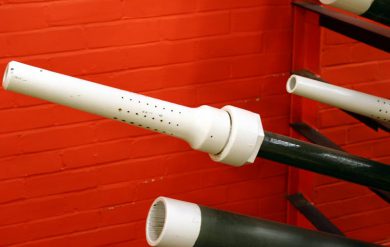During WW2, having increased anti-armor capability was of ever-increasing importance as combat operations progressed. One way of increasing armor penetration was to use the “Squeeze Bore” principal. This principal was initially explored in German small arms design by Karl Puff in the early 1900s, and further explored by Hermann Gerlich in the 1920s. By reducing the size of the bore smaller than the original diameter of the round as it traveled down the barrel, both sectional density and velocity increased. The Germans utilized this principal in the Mauser-Werke produced 2.8 cm Schwere Panzerbüchse 41. Using a breech that would close automatically upon loading, the sPzB 41 had a hydraulic recoil buffer and spring-driven recuperation. There was no traverse/elevation mechanism; the gun was aimed manually. Besides the base model issued to Jägers, there were also packable variants with lighter carriages and no shield issued to Fallschirmjäger and Gebirgsjäger troops. For an even lower profile, the wheels could be removed.
Squeeze bore designs were also utilized in the 4.2cm PaK, and the 7.5cm PaK, which all had tapered bores that would compress a softer outer jacket of the round around a tungsten core. The sPzB 41 even was able to penetrate certain areas of Soviet heavy tanks such as the JS-1, which was impressive at the time for a 2.8cm gun. Service lives of the barrels were short due to the stresses of the design, but a service life of 500 rounds was in the ballpark of the combat life of such weapons systems. An eventual tungsten shortage ended their employment in combat, though many of the 2.8cm guns were mounted on 250 and 251 model halftracks.
The British Army, on the other hand, used a bore-reducing muzzle attachment designed by Czech engineer František Janeček on their Daimler armored cars and Tetrarch tanks. In conjunction with an appropriate “armor piercing super-velocity” round, the Littlejohn adaptor increased muzzle velocities as much as 350fps for a flatter, faster trajectory and more armor penetration capability from a small gun. The problem with the adaptors was that they precluded the use of all other ammunition and had to be removed in order to employ a HEAT round, for example.

Littlejohn adaptor fited to a barrel (Image source: British ordnance collectors network)
There were a few attempts by the US ordnance board and the Soviets to develop weapons using the squeeze-bore principal, none of which proved successful. Ultimately, there are many better options out there for antitank capability these days, but perhaps squeeze-bore or cone-bore barrels will come back into fashion someday.
 Your Privacy Choices
Your Privacy Choices
